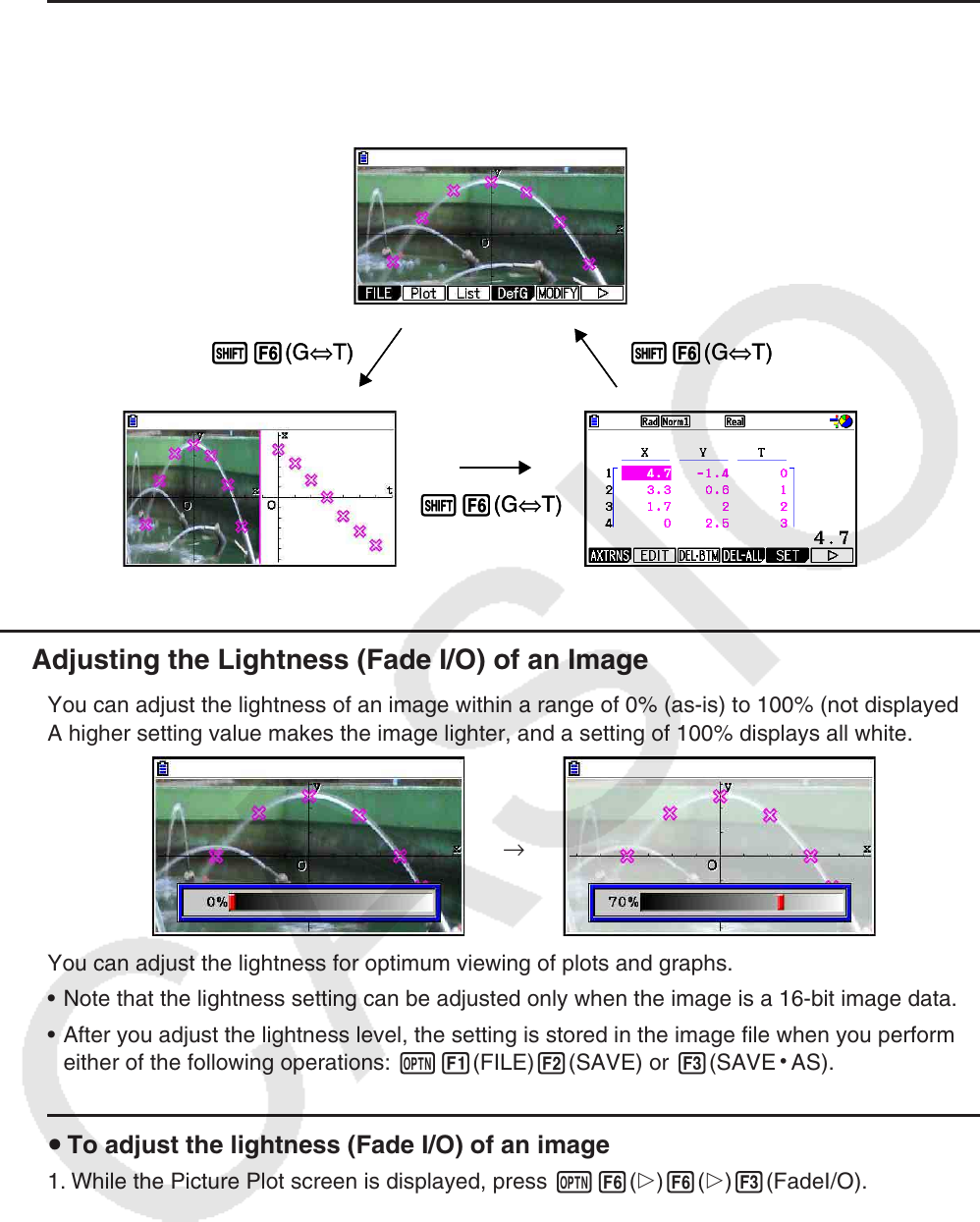User Manual
Table Of Contents
- Contents
- Getting Acquainted — Read This First!
- Chapter 1 Basic Operation
- Chapter 2 Manual Calculations
- 1. Basic Calculations
- 2. Special Functions
- 3. Specifying the Angle Unit and Display Format
- 4. Function Calculations
- 5. Numerical Calculations
- 6. Complex Number Calculations
- 7. Binary, Octal, Decimal, and Hexadecimal Calculations with Integers
- 8. Matrix Calculations
- 9. Vector Calculations
- 10. Metric Conversion Calculations
- Chapter 3 List Function
- Chapter 4 Equation Calculations
- Chapter 5 Graphing
- 1. Sample Graphs
- 2. Controlling What Appears on a Graph Screen
- 3. Drawing a Graph
- 4. Saving and Recalling Graph Screen Contents
- 5. Drawing Two Graphs on the Same Screen
- 6. Manual Graphing
- 7. Using Tables
- 8. Modifying a Graph
- 9. Dynamic Graphing
- 10. Graphing a Recursion Formula
- 11. Graphing a Conic Section
- 12. Drawing Dots, Lines, and Text on the Graph Screen (Sketch)
- 13. Function Analysis
- Chapter 6 Statistical Graphs and Calculations
- 1. Before Performing Statistical Calculations
- 2. Calculating and Graphing Single-Variable Statistical Data
- 3. Calculating and Graphing Paired-Variable Statistical Data (Curve Fitting)
- 4. Performing Statistical Calculations
- 5. Tests
- 6. Confidence Interval
- 7. Distribution
- 8. Input and Output Terms of Tests, Confidence Interval, and Distribution
- 9. Statistic Formula
- Chapter 7 Financial Calculation
- Chapter 8 Programming
- Chapter 9 Spreadsheet
- Chapter 10 eActivity
- Chapter 11 Memory Manager
- Chapter 12 System Manager
- Chapter 13 Data Communication
- Chapter 14 Geometry
- Chapter 15 Picture Plot
- Chapter 16 3D Graph Function
- Appendix
- Examination Mode
- E-CON4 Application (English)
- 1. E-CON4 Mode Overview
- 2. Sampling Screen
- 3. Auto Sensor Detection (CLAB Only)
- 4. Selecting a Sensor
- 5. Configuring the Sampling Setup
- 6. Performing Auto Sensor Calibration and Zero Adjustment
- 7. Using a Custom Probe
- 8. Using Setup Memory
- 9. Starting a Sampling Operation
- 10. Using Sample Data Memory
- 11. Using the Graph Analysis Tools to Graph Data
- 12. Graph Analysis Tool Graph Screen Operations
- 13. Calling E-CON4 Functions from an eActivity

15-12
u To maneuver between the Picture Plot screen, AXTRANS screen, and plot
list screen
Once you display the plot list screen and AXTRANS screen (page 15-14), each press of
!6(G⇔T) cycles between the Picture Plot screen, AXTRANS screen, and plot list screen.
k Adjusting the Lightness (Fade I/O) of an Image
You can adjust the lightness of an image within a range of 0% (as-is) to 100% (not displayed).
A higher setting value makes the image lighter, and a setting of 100% displays all white.
→
You can adjust the lightness for optimum viewing of plots and graphs.
• Note that the lightness setting can be adjusted only when the image is a 16-bit image data.
• After you adjust the lightness level, the setting is stored in the image file when you perform
either of the following operations: K1(FILE)2(SAVE) or 3(SAVE
•
AS).
u To adjust the lightness (Fade I/O) of an image
1. While the Picture Plot screen is displayed, press K6(g)6(g)3(FadeI/O).
• This causes a slider for adjusting image lightness to appear on the display.
2. Use d and e to adjust the lightness value.
• You can also input values directly, if you want. To specify a lightness value of 20%, for
example, press caw.
3. After the setting is the way you want, press w.
!6(G⇔T)
!6(G⇔T)
!6(G⇔T)!6(G⇔T)
!6(G⇔T)
!6(G⇔T)










